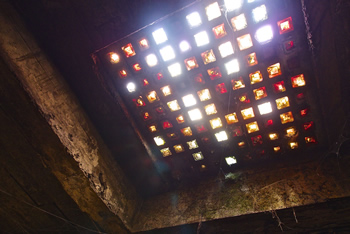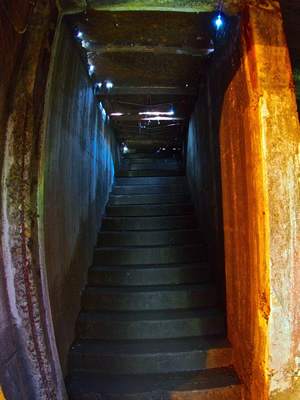ob•tain•i•um
the ability to get something that is not so easy to come by. It mostly means to acquire an item but keeping its prior meanings in mind helps you to use it in the right way.
"Love the new lamp...is that obtainium?"

At 2:00 a.m. on December 8, 1922, the first shouts of "Fire!" sounded in Astoria's business district. The area was soon engulfed in flames and burned out of control as the city was built of wood and was destroyed with 30 downtown blocks in rubble and an estimated loss of $12,000,000. Astoria was promptly rebuilt after the fire and Commercial Street today remains much the same as it appeared after its 1920s restoration.
And underneath the streets and sidewalks is a time capsule of history waiting to be discovered. Astoria Underground also known as NOOOOOOO explores and surveys underground features for which they have the necessary skills and equipment to discover the long lost 100 year old tunnels. Stories are told that Shanghai tunnels were located beneath Astoria that were used to transport goods and legend has it, people, kidnapping men for forced labour aboard sailing ships. On the academic side, they carry out research into old records with photography as well as talking to elderly residents whose memories are invaluable.

A unique opportunity for local artists to project their temporary works of art onto some of the most un-noticed buildings in downtown Astoria, leaving a lasting impression.
Illuminart fuses art, lighting and technology, unfolding through downtown Astoria. Aimed at an inquisitive audience, eager to discover and explore, illuminart assembles projects by artists, creators, graphic designers and videographers. Blank walls at varius locations will spring to life, becoming a must-see destination for creativity, inspiration and shared experience.

The original Astoria Theatre was constructed in the 1890's and was destroyed by the fire in 1922. In 1925 it was rebuilt and a 18'x3' sign was erected on the building that today houses Wells Fargo.
In 1938, First National Bank moved in and the sign was removed and put in the basement of the Liberty Theater and was forgotten about until the renovation began in 2004. The sign ended up in a scrap yard in Seaside until John Goodenberger and Mitch Mitchum claimed it and returned it to Astoria where it has been stored in a basement under the streets.
In recognition of the contributions Mitch has made in Astoria, volunteers have joined together to once again save the sign and re-light the 300 lights and retro-restore it to be placed inside the new Carruther's Restaurant across the street from it's original home. Jimbo Defeo, in photo below, provided (2) $100.00 restaurant certificates to the Armory to use for fundraising opportunities in exchange for 2 months of storing during the restoration process of the Astoria sign.
This winter, an old, large, one-word, electric sign emerged from the basement of the Liberty Theater. It read, "Astoria." Spectators wondered if it was formerly used at the town's entry or if it was used by a local business. The sign belonged to the long-gone Astoria Theatre.
The first Astoria Theatre was located on the southeast corner of 12th and Exchange. Originally known as the Fisher's Opera House, it was home to vaudeville, live theater and early silent films. It is also reputed to have been where Clark Gable began his acting career. He performed on the stage there in the summer of 1922.
— John Goodenberger -- For The Daily Astorian
read full story here
Hoping to bring a neighborhood feel downtown, a parking space and a loading zone outside of Cargo on 11th Street will soon get converted into a parklet.
Wooden benches will be placed on the street near the curb so people can enjoy a cup of coffee or take a break. The urban street design is popular in Portland, Seattle and San Francisco, so Astoria agreed to experiment with the tiny parks.
Jim Defeo, who is behind Cargo, the Astoria Coffeehouse & Bistro and Carruthers restaurant, is sponsoring the parklet. The benches and other features have been designed by artist Jeff Daly using reclaimed wood and other recycled materials. Defeo may add tables and other improvements.
Michele Reeves, an urban strategist, had urged the city in 2012 to make downtown more vibrant and walkable, even at the expense of coveted parking spaces.
"That's what we want to do," Daly said. "We want to see people downtown, daytime and nighttime, celebrating their businesses and taking care of our business owners."
"I'm anxious to see it," City Councilor Russ Warr said. "I think it will be interesting."
— Derrick DePledge
read full story here

Vault Lights, also known as Sidewalk Lights or Prism Lights, are glass squares set into sidewalks to let light into vaults and basements below. Easily overlooked and sometimes mistaken for decorations, glass tiles embedded in the sidewalk are often indicators of subterranean rooms. Prisms were used instead of flat glass to disperse the light, diffusing it over a large area; plain flat glass would simply form a bright spot on the floor below, not providing much useful general lighting. The glass was not colored, it turned purple over the years due to exposure to sun.
The concept behind vault lights originated in 1840 with glass "deck lights" used on the decks of ships in order to illuminate their cargo hold without the use of candles or lanterns, reducing the risk of fire. Starting in 1845, different systems of glass lenses embedded in concrete or steel were patented for use in sidewalks. They met with great success, and building codes began to recommend vault lights as a fireproof source of light for basements.
Their use declined as electric light became cheaper and better, and by the 1930s were on their way out. Now, they are endangered relics and can only be found in a handful of cities across the country. Astoria has more than 45 squares of sidewalk prism lights on Commercial and Duane streets and ranks as one of the largest collections in the country. Many of the prisms are missing and are in need of repair and Astoria's Studio 11 is reproducing the tiles with great success.
Obtainium Studio works with building owners to light the prisms from underground to create a mystical and dramatic entrance to their storefronts.
Have you ever wondered about the grids with the little colored squares of glass embedded in downtown Astoria sidewalks? Jeff Daly must be psychic, because just as the Ear was pondering the question, an email popped up from him that provided a few answers from http://glassian.org
For one thing, historically, the pieces of glass were shaped like conical lenses (pictured inset) to disperse the light more evenly. They were embedded in a 4-foot by 4-foot grid of 100 (10 on each side). Originally made of clear glass, years of exposure to the sun changed the color to purple.
The idea actually originated as an adaptation of glass deck lights, used on ships to illuminate the cargo hold. In the 1800s, these sidewalk prism lights (also called vault lights) were a handy and safe way to get natural light into basements below the sidewalk. When electricity became popular, vault lights weren't needed, and the practice of installing them died off.
It's estimated that Astoria has around 40 of these grids in the downtown core - from Fifth to 17th streets, and from the Columbia River to Exchange Street - many in sad shape. You can see a map at www.sidewalkglass.com
Studio 11, in conjunction with the Astoria Downtown Historic District Association's (ADHDA) Sidewalk Tile Replacement Program (www.astoriadowntown.com), is making glass replicas to replace the damaged squares. The replacements are not true prisms, but are made to look as close as possible to the original in shape and color. And, as an incentive to businesses and property owners, the ADHDA is offering to reimburse 50 percent of the cost of replacing tiles that present a tripping hazard or pedestrian safety issue.
Wouldn't it be grand if all of the broken or missing tiles downtown were restored?
— Elleda Wilson